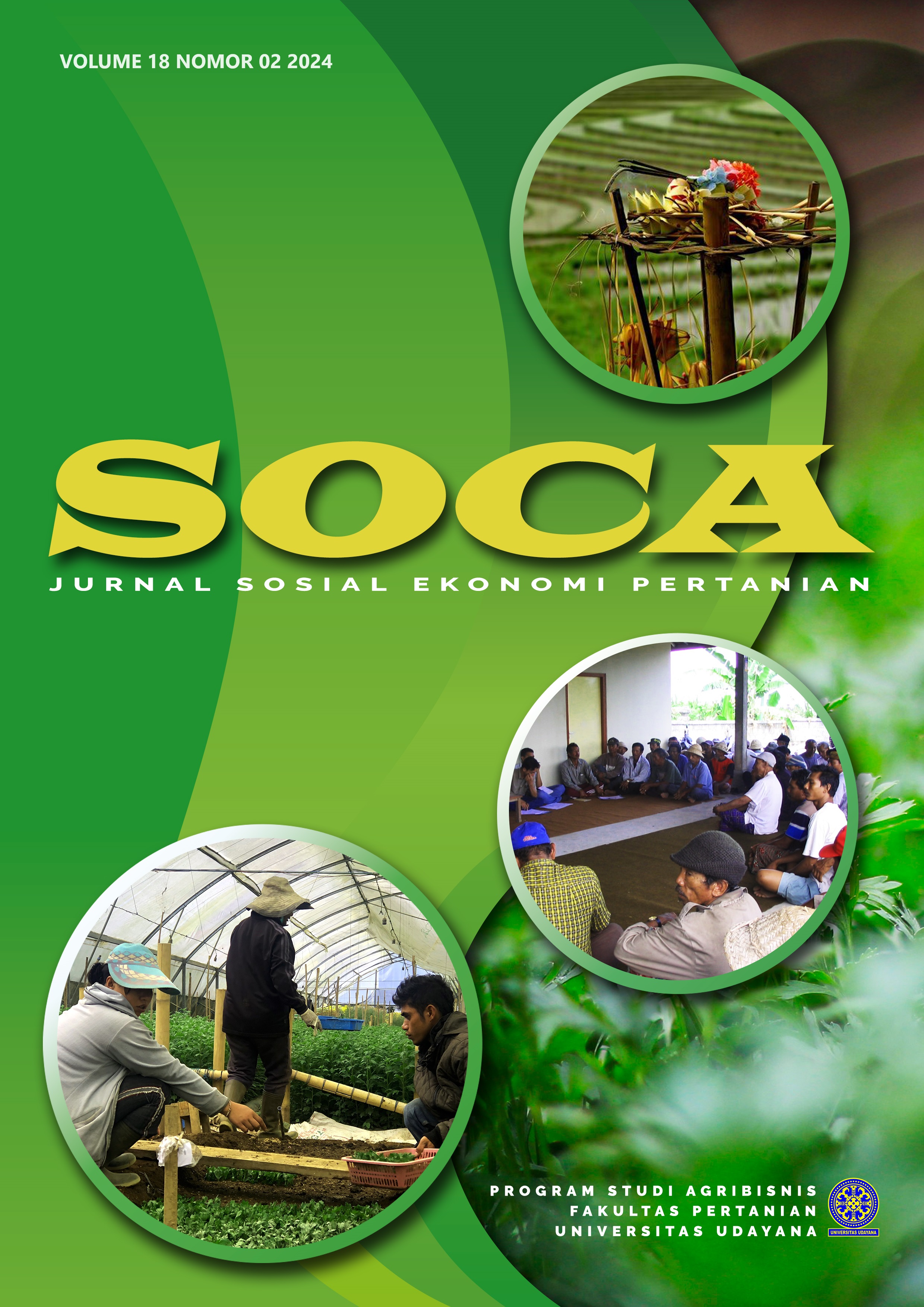Competitiveness of Indonesian Clove Exports in the International Market
Abstract
Clove production in Indonesia is not only aimed at meeting domestic needs but also targeted to fulfill export demands in the international market. This study aimed to analyze the competitiveness of Indonesian clove exports and examine the factors influencing the volume of Indonesian clove exports to ten main destination countries. The research method utilized was Secondary Data Analysis. The data employed in this study consist of secondary data in the form of time series and cross-sectional data from the top ten destination countries for Indonesian clove exports during the period 2001 – 2022. The data analysis techniques included Revealed Comparative Advantages analysis and panel data regression (gravity model) using the Random Effect Model with Cross-Section Seemingly Unrelated Regression weighting. The research findings indicate that, in general, Indonesian clove commodities in the top ten destination countries exhibit strong competitiveness, as evidenced by the average Revealed Comparative Advantage (RCA) of Indonesian cloves in these countries being greater than one (>1). Additionally, the panel data regression results demonstrate that the real Gross Domestic Product per capita of Indonesia, the real Gross Domestic Product per capita of the destination countries, the population of the destination countries, and the real exchange rate have a positive and significant impact on the volume of Indonesian clove exports. Conversely, the economic distance variable has a negative and significant impact on the volume of Indonesian clove exports.
Downloads
References
Badan Pusat Statistik. (2021). Luas Areal Tanaman Perkebunan Rakyat Menurut Jenis Tanaman (Ribu Hektar).
Badan Pusat Statistik. (2021). Produksi Perkebunan Rakyat Menurut Jenis Tanaman (Ribu Ton).
Greene, W. H. (2002). Economic Analysis Fifth Edition Prentice Hall. New York: Hall International, Inc.
Gujarati, D. N., Porter, D. C. (2015). Dasar-Dasar Ekonometrika II (5th ed). Jakarta: Penerbit Salemba Empat.
Humaira, F. A., & Rochdiani, D. (2021). Faktor-Faktor Yang Mempengaruhi Volume Ekspor Kayu Manis Indonesia. Jurnal Pemikiran Masyarakat Ilmiah Berwawasan Agribisnis, 7(1), 437–449.
Hakam, L. I. & Firmansyah. (2019). Analisis Daya Saing Dan Faktor-Faktor Yang Memengaruhi Permintaan Batu Bara Indonesia Di Negara Tujuan Ekspor Utama. Jurnal Diponegoro, 1(1), 31–46.
Karlina, C. J., Winarti, A. S., & Sodik, J. (2022). Analisis Ekspor Minyak Kelapa Sawit (CPO) Indonesia ke Sepuluh Negara Tujuan Utama Tahun 2008 – 2020. Jurnal Sinomika, 1(4), 851–864.
Kementrian Pertanian. (2022). Outlook Komoditas Perkebunan Cengkeh. Pusat Data dan Sistem Informasi Pertanian Sekretariat Jenderal – Kementerian Pertanain. Jakarta.
Maulana, A., & Kartiasih, F. (2017). Analisis Ekspor Kakao Olahan Indonesia ke Sembilan Negara Tujuan Tahun 2000 – 2014. Jurnal Ekonomi dan Pembangunan Indonesia, 17(2), 103–117.
Nalurita, S., Asmarantaka, S. N., & Jahroh, S. (2014). Analisis Daya Saing dan Strategi Pengembangan Agribisnis Kopi Indonesia. Jurnal Agribisnis Indonesia, 2(1), 63–74.
Nurhayati, E., Hartoyo, S., & Mulatsih, S. (2019). Analisis Pengembangan Ekspor Pala, Lawang, dan Kapulaga Indonesia. Jurnal Ekonomi dan Pembangunan Indonesia, 19(2), 173–190.
Pinto, J. D. S., Suharno., & Rifin, A. (2022). Kinerja Ekspor Cengkeh Indonesia di Pasar India: Pendekatan Linear Approximate Almost Ideal Demand System (LA/AIDS). Jurnal Agribsisnis Indonesia, 10(2), 262–279.
Rambe, R. K., & Malau, L. R. E. (2023). Tingkat Daya Saing dan Faktor-Faktor Yang Mempengaruhi Aliran Perdagangan Kayu Manis Indonesia. Jurnal Agromix, 14(1), 28–38.
Trade Map. (2023). https://www.trademap.org. (diakses tanggal: 10 Oktober 2023).
Widarjono, A. (2013). Ekonometrika Pengantar dan Aplikasinya. Jakarta: Penerbit Ekonosia













